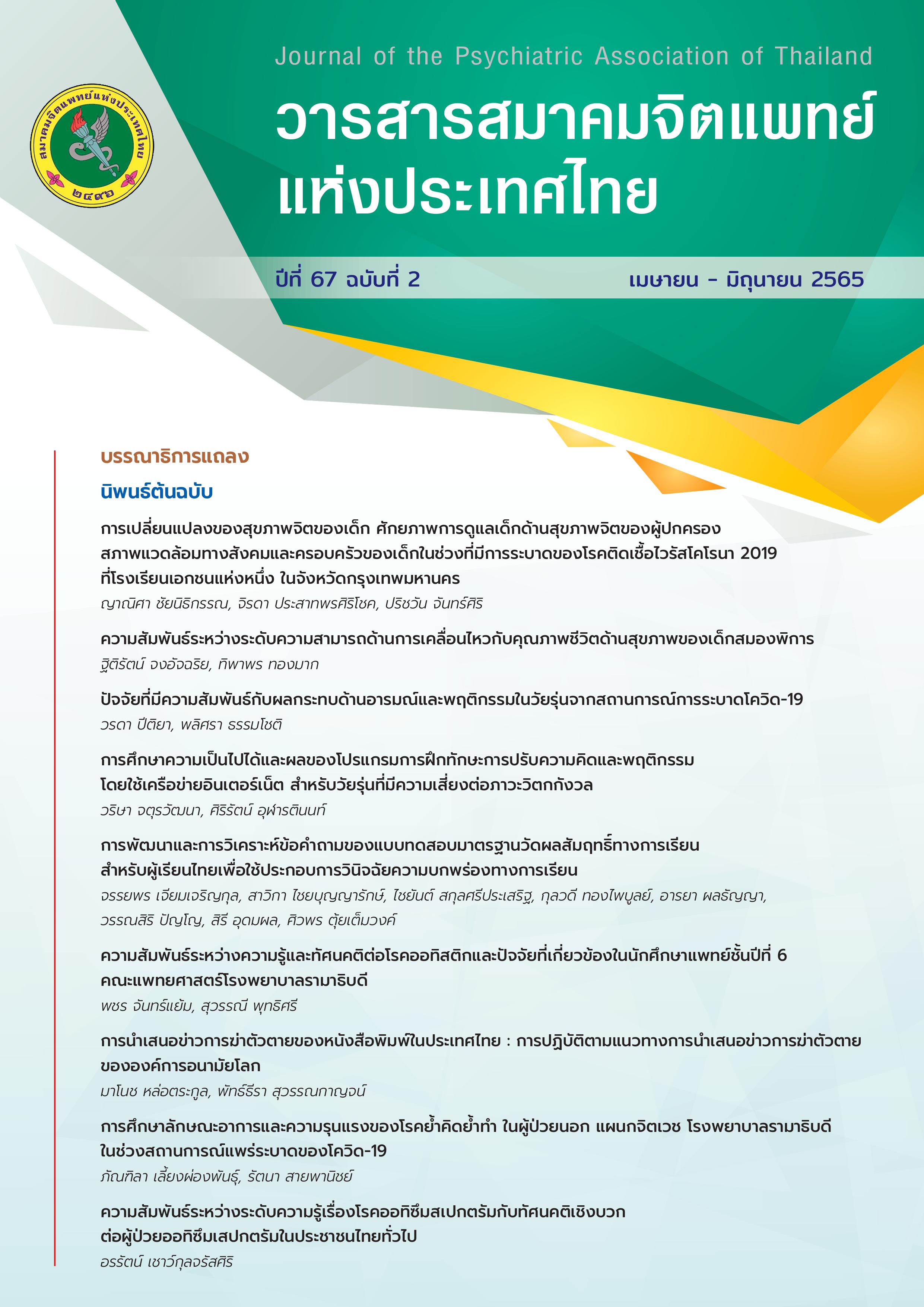Association between Gross Motor Functions and Health-Related Quality of Life in Children with Cerebral Palsy
Main Article Content
Abstract
ABSTRACT
Objective : To determine the association between gross motor functions and health-related quality of life in children with cerebral palsy
Methods : A cross-sectional study was conducted from May 1st, 2019 to April 30th, 2020. The data was collected from primary caregivers of children with cerebral palsy aged 4-12 years attending out-patient department of physical medicine and rehabilitation and department of pediatrics, Hatyai Hospital. The cerebral palsy quality of life questionnaire (CP QOL-Child) for parent proxy-report-Thai version was used to assess quality of life among children with cerebral palsy. Gross motor function was assessed by Gross Motor Functional Classification System Expanded and Revised (GMFCS - E&R). The collected data were analyzed using descriptive statistics and Spearman’s rank correlation coefficient were used to determine the correlation between dimensional the stratum of GMFCS - E&R and scores of CP QOL-Child.
Results : Most children, age 4-12 years with cerebral palsy were male (68.8 percent) and had mean age 7.3 years old. With regard to caregivers, most of them were parents, with more females (75.5 percent) than males, and they had mean-aged 37.7 years old. Most children were GMFCS- E&R level I and IV (29.4 percent) followed by level V (21.1 percent). The social well-being and acceptance domain had the highest mean score, was 868.6 ± 142.3. On the other hand, the pain and impact disability had the lowest mean score, 200.0 ± 145.2. Moreover, the GMFCS- E&R had the negative correlation with the mean of the overall CP QOL child score (r = -.554, p<.01).
Conclusion : The cerebral palsy children with the lowest stratum of gross motor function tended to have the negative correlated with the overall CP QOL child score. This study has the utility for the physician, who take care the patient to have the multidisciplinary care plan.
Article Details

This work is licensed under a Creative Commons Attribution-NonCommercial-NoDerivatives 4.0 International License.
Articles submitted for consideration must not have been previously published or accepted for publication in any other journal, and must not be under review by any other journal.
References
Rosenbaum P, Paneth N, Leviton A, Goldstein M, Bax M, Damiano D, et al. A report: the definition and classification of cerebral palsy April 2006. Dev Med Child Neurol Suppl 2007; 109:8-14.
Colver A, Fairhurst C, Pharoach PO. Cerebral palsy. Lancet 2014; 383:1240-9.
Thongmak T, Jongutchariya T. Risk factors and associated disorders of cerebral palsy in pediatric patients in Hatyai hospital. Thai J Ped 2019; 58:95-102.
Cerebral palsy Alliance. Gross Motor Function Classification System (GMFCS). [Internet] [cited 2019 Jun 1]. Available from:
Siritaratiwat W, Thomas I. GMFCS- E&R Thai Translation. [Internet]. 2007. [cited 2019 Jun 1]. Available from: http://canchild.
ca/system/tenon/assets/attachments/000/000/081/original/GMFCS-ER Translation-Thai.pdf.
Gorter JW, Rosenbaum PL, Hanna SE, Palisano RJ, Bartlett DJ, Russell DJ, et al. Limb distribution, motor impairment, and functional classification of cerebral palsy. Dev Med Child Neurol 2004; 46(7):461-7.
Beckung E, Carlsson G, Carlsdotter S, Uvebrant P. The nature history of gross motor development in children with cerebral palsy aged 1 to 15 years. Dev Med Child Neurol 2007; 49(10):751-6.
Tessier DW, Hefner JL, Newmeyer A. Factors Related to Psychosocial Quality of Life for Children with Cerebral palsy. Int J Pediatri [Internet]. 2014. [cited 2019 Mar 1]. Available from: http://dx.doi.org/10.1155/2014/204386.
Davis E, Shelly A, Waters E, Davern M. Measuring the quality of life of children with cerebral palsy: comparing the conceptual differences and psychometric properties of three instruments. Dev Med Child Neurol 2010; 52(2):174-80.
Australasian Academy of Cerebral palsy and Developmental Medicine. The Cerebral Palsy Quality of Life Questionnaire. [Internet]. 2013 [cited 2019 Mar1]. Available from: http://www.Ausacpdm.org.au/
Kwanchanok S, Prasetsukdee S, Khajornchaikul P. Test-retest reliability and internal consistency of Cerebral Palsy Quality of Life Questionnaire (Thai version). Thai J Phys Ther 2014;36(2):60-9.
Pirpiris M, Gates PE, McCarthy JJ, D’Astous J, Tylkowksi C, Sanders JO, et al. Function and well-being in ambulatory children with cerebral palsy. J Pediatr Orthop 2006;26(1):119–24.
Vargus-Adams J. Health-related quality of life in childhood cerebral palsy. Arch Phys Med Rehabil2005;86(5):940–5.
Shelly A, Davis E, Waters E, Mackinnon A, Reddihough D, Boyd R,et al.The relationship between quality of life and functioning for children with cerebral palsy. Dev Med Child Neurol2008;50(3):199-203.
Liabsirinon S, Tantilipikorn P, Mahasup N. Interrater reliability of Thai version of gross motor function classification system (GMFCS) in Thai children with cerebral palsy. Thai J Phys Ther 2008;30(1):26-36.
Portney LG, Watkins MP. Foundations of Clinical Research: Applications to Practice. 2nd ed. Upper Saddle River, NJ: Prentice Hall, 2000.
Gharaborghe SN, Sarhady M, Hosseini SM, Mortazavi SS. Quality of life and gross motor function in children with cerebral palsy (aged 4-12). Iran Rehabilit J 2015;13(2):58-62.
Das S, Aggarwal A, Roy S, Kumar P. Quality of life in Indian children with cerebral palsy using cerebral palsy-quality of life questionnaire. J Pediatr Neurosci 2017;12:251-4.
Anggreany D, Saing JH, Deliana M, Dimyati Y. Comparison of the quality of life in cerebral palsy children with physical therapy more and less than 10 months. Paediatr Indones 2015; 55:287-92.
Mohammed FM, Ali SM, Mustafa MA. Quality of life of cerebral palsy patients and their caregivers: A cross sectional study in a rehabilitation center Khartoum-Sudan (2014 – 2015). J Neurosci Rural Pract 2016;7(3):355-61.
Livingston MH, Rosenbaum PL, Russell DJ, Palisano RJ. Quality of life among adolescents with cerebral palsy: What does the literature tell us? Dev Med Child Neurol 2007;49(3):225-31.
Liu WY, Hou YJ, Wong AM, Lin PS, Lin YH, Chen CL. Relationships between gross motor functions and health-related quality of life of Taiwanese children with cerebral palsy. Am J Phys Med Rehabil 2009;88(6):473-83.
Saka MJ, Odunewu MA, Saka AO, Akinwale SG, Anjorin OU. Quality of life of children with cerebral palsy: Accumulative effect of physiotherapy intervention in North Central and Southwest Nigeria. Afr J Physiother Rehabil Sci 2017;9(1-2):27-33.


